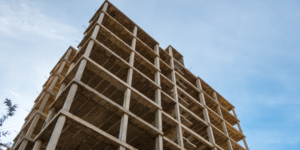
Though the construction of Greenville, South Carolina’s new federal courthouse was completed in August 2021, the greater process of payment surrounding it has yet to cease.
A January 26, 2022, lawsuit from project subcontractor Manganaro Southeast, LLC alleges that its subcontractor JMM Construction, Inc. “abandoned” the project almost a year prior to its eventual completion.
On top of this, Manganaro Southeast claims that JMM Construction actually used its own subcontractors on the project without the knowledge or permission of the company.

A first-tier subcontractor for project general contractor Brasfield & Gorrie, LLC, Manganaro Southeast claims to have entered its contract with JMM Construction in May 2020. JMM Construction’s contract obligated it to provide labor for the installation of drywall and wall insulation, making it a second-tier subcontractor on the project.
However, according to Manganaro Southeast, JMM Construction “completely abandoned” the project on November 16, 2020, leaving it in default of its subcontract.
Due to this, Manganaro Southeast claims that it was required to complete the project using its own workforce and after hiring a replacement subcontractor on the project, while also paying JMM Construction’s third-tier subcontractors for their work prior to the alleged “abandonment.”
As part of its lawsuit, Manganaro Southeast is claiming a total of $1,754,091.86 in damages stemming from the situation.
This lawsuit is an example of how far-reaching these types of situations can be for contractors. Besides damaging their reputation on this individual project, court documents note that JMM Construction has other additional contracts with Manganaro Southeast.
The situation also points out the importance that contractor prequalification can have on any given project, especially when it comes to mitigating risk management.
“Before hiring someone, or taking on a job, it’s important to have a good idea of the character and capacity on the other side of your contract,” says construction lawyer Alex Benarroche. “One bad egg could affect the project schedule, the quality of performance, project safety, and it could even determine whether payment disputes will occur. Establishing a prequalification process can help contractors, subs, and suppliers minimizes risk.”
Preliminary notices are a similarly important part of establishing relationships between contractors on any given project, especially when there’s a risk of having unknown lower-tier contractors involved. Sending a preliminary notice simply passes information between all of the different parties on a construction job, and can help to establish roles and keep project leaders in the know.
“Sending preliminary notice informs the parties in charge of the project of your involvement. You might be thinking, ‘of course they know I’m involved!’ but it’s rarely this simple,” says Levelset’s Olivia Huppman.
“If you were hired by the general contractor or some other third party, it’s very likely the property owner has no idea what your role is on the project and how much you expect to be paid. This problem is compounded on large projects which might have dozens of tiers of hiring.”
For a situation where a project has unauthorized lower-tier contractors, the situation becomes even more difficult than what Manganaro Southeast has dealt with.
The Miller Act helps protect contractors on federal construction projects from any nonpayment, as general contractors on any government project are required to take out a payment bond on the project. It’s a powerful tool to protect first-tier and second-tier subcontractors — but it’s important to note that that is as far down the chain as the protection goes.
Anyone lower than a second-tier contractor on a project doesn’t have Miller Act rights. This problem extends to suppliers as well — only suppliers who are working with the general contractor or a first tier subcontractor have Miller Act rights on a project, with farther-removed
On top of the alleged lack of permission in JMM Construction’s use of unauthorized contractors on this project, it’s just a dangerous position for these third-tier contractors to be in if they end up in a situation of nonpayment — which, according to the lawsuit, they did.
According to the lawsuit, “JMM Construction sought and took payment from (Manganaro Southeast) for work performed by JMM’s laborers and subcontractors but then wrongfully failed to pay that money down to those laborers and subcontractors.” In fact, over $1 million of Manganaro Southeast’s alleged damages stemmed from paying these unauthorized third tier subcontractors for their work.